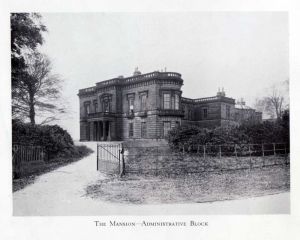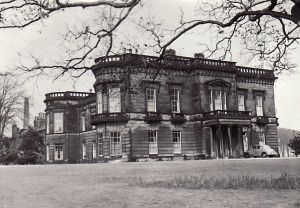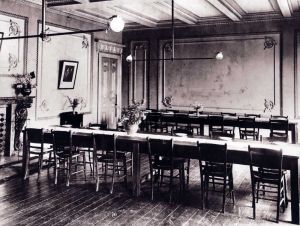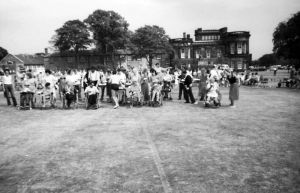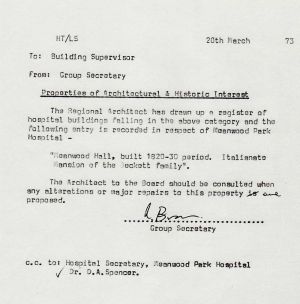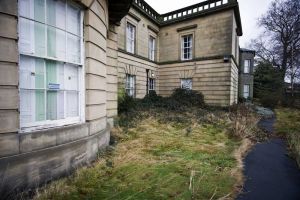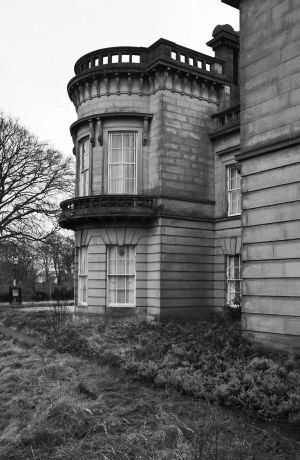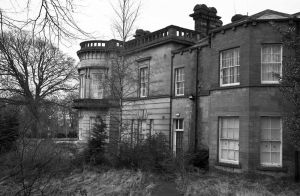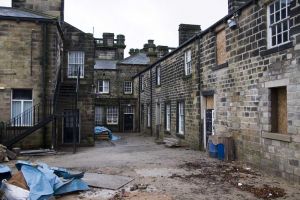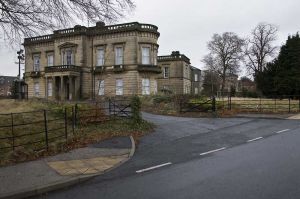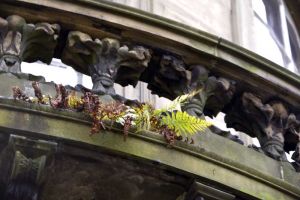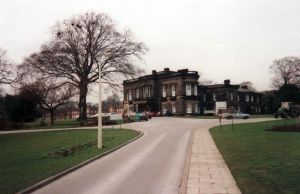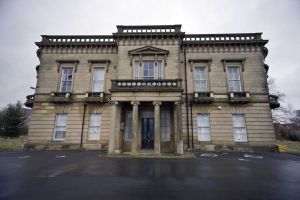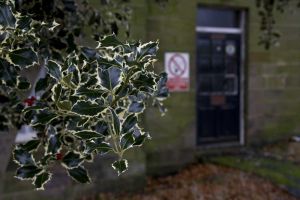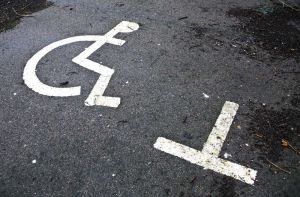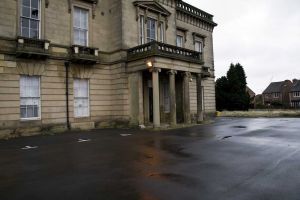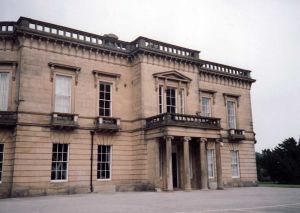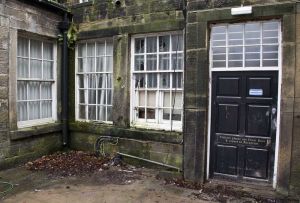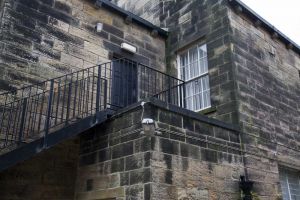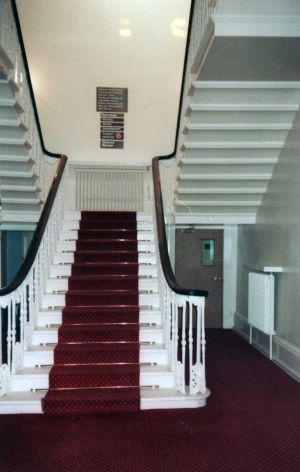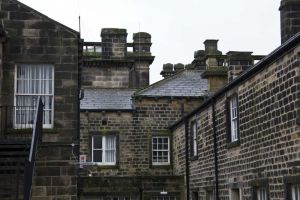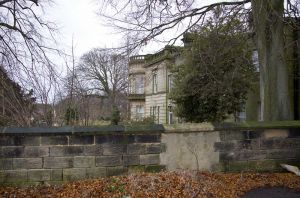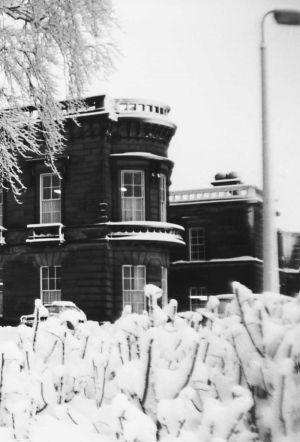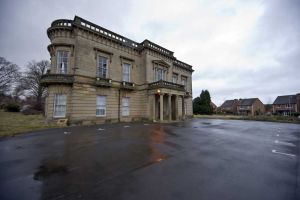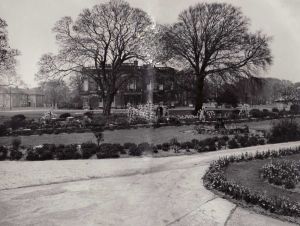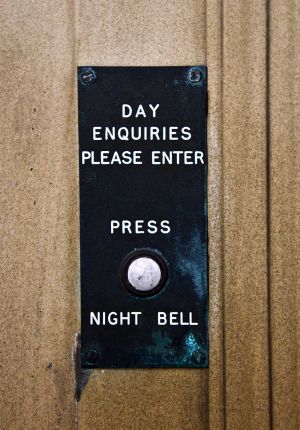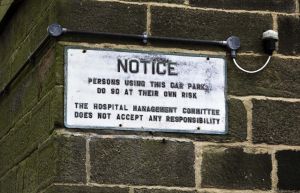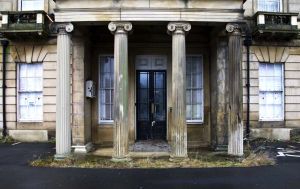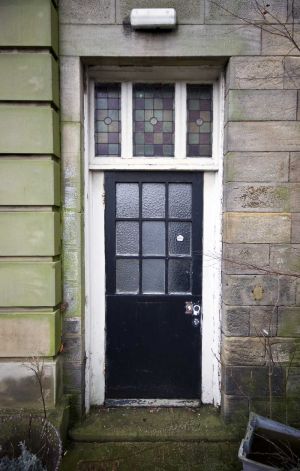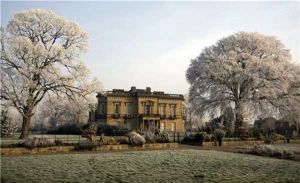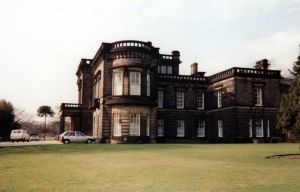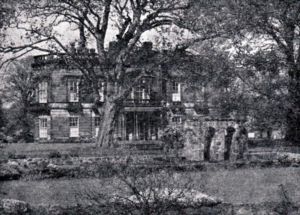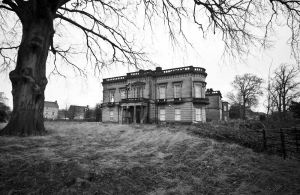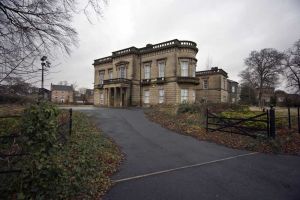In 1762 Thomas Denison (1720 – 1796) of Leeds, purchased a dwelling house and thirteen acres at ‘Mesnewood (sic) otherwise Hawcaster Rigg in Chapel Allerton… and there built his home – Meanwood Hall.
Thomas died in France leaving his estate to his wife, Elizabeth, for life and then to his son Robert. Elizabeth vacated the Hall shortly after her husband’s death when it was described in an advertisement in the Leeds Intelligencer as containing ‘four spacious rooms on the ground floor, with very good bedrooms over, kitchen, pantries, servants’ hall, coach house, stabling for ten good horses and about twenty acres of land’. For some years the estate was let – the various tenants including Thomas Turton, the Countess of Aberdeen, Sir John Beckett (who owned two adjacent cottages) and Joseph Lees respectively.
The Becketts came originally from Barnsley and it was the tenancy of Sir John (1743 -1826), a banker, who later lived at Gledhow Hall, that forged the first link in the families association with Meanwood, which was to last for over a 100 years.
Sir John’s son Christopher, also a banker, bought the property from Robert Denison in 1824, the part and estate by then having grown considerably due to purchases and by allotments under the Chapel Allerton Enclosure Act. Incidentally, the conveyance included ‘ all that pew, seat or sitting being number 44 in the middle aisle of the Episcopal Chapel of Chapel Allerton now or late in the occupation of Joseph Lees’.
Christopher Beckett (1777 – 1847) JP, a Deputy Lord Lieutenant of the West Riding and twice Mayor of Leeds, resided at Meanwood Park, as it came to be know, and was noted for his ‘ support of the calls of religion and the claims of charity.’ He made alterations and additions to the south side of the Hall about 1830, the architect being John Clark, and extensively increased his Meanwood estate by other purchases. After his death in 1847 his unmarried sisters, Mary and Elizabeth, continued to live at the Hall until their deaths in 1858 and 1864 respectively.
Christopher, a bachelor, died without having made a will and the property passed to his elder brother, Sir John Beckett (1775 – 1847), who died a few weeks later. All the Chapel Allerton property, which included Meanwood Park, together with the hereditary title, then passed to the next surviving brother, Thomas Beckett (1779 – 1872) of Somerby Park, Gainsborough. His daughter. Mary, a spinster inherited a life interest but it was to the children of his younger daughter, Elizabeth, wife of Sir Henry Hickman Bacon, that the estate finally passed.
After the death in 1864 of Christopher Beckett’s sister, Elizabeth. MPH was once again occupied by tenant’s, the first being Christopher’s nephew William Beckett Denison. The Hall was unoccupied from about 1872 – 1875 when it was let to Joshua Bower who was joined in the following year by his brother, R.W. Bower, both described as colliery owners; it is a local tradition that the two brothers, who dined together, never spoke to one another. R.W Bower appears to have been the last ordinary tenant of Meanwood Park.
The Hall was destine to have one more private and probably rent free occupier – John Ford Smart, the woodman, perhaps employed by the Beckett family. He lived in the woodman’s cottage almost on the edge of the quarry, the worked out part of which was used in 1917 and 1918 for the testing of guns made in Hunslet. Because of the noise and damage to his cottage he made a strong plea for a house a safe distance from the quarry and the Smart family of five was moved into the Hall, which it was said had enough rooms to provide ten for each member of the family!
In 1919 Leeds Corporation rented Meanwood Park to provide a ‘colony’ for the mentally handicapped, which was formally opened on 3rd June 1920, although the first patient had been admitted in the previous year. In 1921 the Corporation bought Meanwood Park estate and surrounding land totalling in all one hundred and seventy eight acres, from Sir Hickman Beckett Bacon of Thonock, Gainsborough, grandson of Sir Thomas Beckett. Originally 87 patients were accommodated in the Hall, but during the following twenty years villas were built in the grounds and by 1941, beds were provided for 841 patients. The Hall by then referred to as ‘The Mansion’ was used for other hospital purposes. MPH was taken over by the NHS in 1948 and administered by Leeds (group B) Hospital Management Committee. It is now the responsibility of the Leeds Eastern Health Authority and accommodates about 460 residents.
Early in the 19th century there were a few small cottages close to Meanwood Hall which were owned by the Overseers of the Poor of Chapel Allerton. It appears that Robert Denison did not like these dwellings near to his mansion so they were demolished; the site being exchanged for a plot of land on the edge of the Park won which were built 4 single storey cottages for the poor. In July 1845 the record and account book of the Overseers states ‘the committee agrees to Mr Beckett’s proposal respecting the removal of poor houses, provided the committee approve the site (sic) of the buildings proposed to be erected.’ Later in the same year at a special meeting this matter was considered again when it was agreed ‘that the site adjoining the Alwoodley Road near John Glow’s house be selected for the new poor houses, and that Mr Oates and the Overseers he requested to inspect the site and houses during their erection.’ The 4 poor houses were ever built on the Alwoodley Road (King Lane) is not known but as Christopher Beckett died within 2 years of the scheme being approved it is possible that no action was taken.
The 4 single storey cottages ‘for the poor’ now demolished, which were on the edge of the Park (Parkside Road) were included in the property bought by the Corporation in 1921 and transferred to the Health Authority in 1948.
Even before Christopher Beckett bought Meanwood Hall, however, his younger brother William (1784 – 1863), had purchased three closes of land and a parcel of wood ground at Woodside in 1810 together with a considerable tract of land to the east of Stonegate Road. William a very rich banker was a considerable force in the commercial affairs of Leeds which he represented in Parliament. For a time his residence was Kirkstall Grange (formerly New Grange) in Beckett’s Park – now part of Leeds Polytechnic formerly the City of Leeds Training College. After he died his Meanwood property came under the control of his younger brother, Edmund Beckett (1787 – 1874) who married Maria Beverley. This union linked the Denison and Beckett families as Maria was the heiress of Lady Ann Denison wife of Sir Thomas Denison (1697 – 1765) a kinsman of Thomas Denison, the builder of Meanwood Hall.
Lady Ann’s trustees purchased the manor of Grimthorpe in the East Riding which ultimately devolved on Maria, and Edmund assumed the name and arms of Denison. On his succession to the Baronetcy in 1872 when his brother Thomas died, however, he discontinued the name Denison and became Sir Edmund Beckett.
His eldest son Edmund Beckett Denison (1816 – 1905) QC, MP, who also relinquished the name Denison, was created Baron Grimthorpe in 1886. Recognised as an authority on clocks, he invented a three legged escapement, later used in all good turret clocks. Baron Grimthorpe and his wife, Fanny Catherine, daughter of the late Rt Rev. John Lonsdale, Bishop of Lichfield are buried close to the north side of St Alban’s Cathedral of which Lord Grimthorpe was a great benefactor.
The Meanwood property of his branch of the family was finally sold to Leeds Corporation and Ernest Haley in 1919 and 1939 respectively by Ralph William Ernest Beckett, Third Baron Grimthorpe
Meanwood Hall
Extracts from the book ‘Meanwood’ (1986) by W Arthur Hopwood and Frederic P Casperson (pages 54 – 57)
Historical Notes on ‘The Mansion’
The original Meanwood Hall is dated from 1860s. In 1762 Thomas Denison (1720 – 1769) of Leeds bought a dwelling house and 13 acres at Hawcaster Rigg in Chapel Allerton and built his home, Meanwood Hall. The name was then “Mesnewood”. The various occupants of the Hall since then are described in a recent publication by Mr W Arthur Hopwood and Mr Frederick P Casperson, “Meanwood” (price £2.40) on the history of Meanwood and the surrounding locality.
The exterior of The Mansion
Three distinct forms of stone work can be seen
1. The West Wing dated 1814 – 1815 is now the oldest part, built of rough stone
2. The East Wing has smooth stone
3. The front of the Mansion is in tooled stone which may have been a facing or, more probably, it is thought now a rebuilding, about 1825 -1830,
the architect being John Clark. The porticoed entrance was not made wide enough for carriages to enter between the columns and the door.
An ornate window in the West Wing could well have been in a chapel when the wing formed part of “an academy for young gentlemen”.
The Interior of The Mansion
The outstanding feature is the decorated ceiling of the hall and landing. Hooks in the walls were probably used for the hanging of tapestries. When ‘Meanwood Park Colony’ was first opened rooms in ‘The Mansion’ were used to accommodate patients. Old photographs show rooms recognisable as the present committee/board room (room1 and 2) used for this purpose. The committee/boardroom remains intact, but other large rooms have been divided up over the years in various ways. The form of original rooms can still be identified from the patterns of ceilings, cornices and doorways and also some of the original doors double lock.
The present stone building which accommodates the Hospital Shop is thought to be old like ‘ The Mansion’. A thoroughfare in this area was called Mallory Road. The ground sloping south westwards from ‘The Mansion’ on which stands the Nurses home building was known as Hawcaster Rigg.
The giant beech tree in front of ‘The Mansion’ pre dates it and is thought to be well over 200 years old (Hawcaster Rigg might give ideas for anyone wanting to name a building).
The Residents of Meanwood hall
1762 Thomas Denison built Meanwood Hall. Thomas died in France and left the estate to his wife, Elizabeth, for life and then to his son, Robert.
Elizabeth vacated the Hall shortly after her husband’s death.
For some years the estate was then let to various tenants who included Thomas Turton, the Countess of Aberdeen, Sir John Beckett and Joseph Lees (1814) respectively.
1824 Christopher Beckett (1777 – 1847) a banker, bought the property from Robert Denison. Christopher Beckett JP Deputy Lord Lieutenant of the
West Riding, was twice Mayor of Leeds and resident at ‘Meanwood Park’.
1830 He made alterations and additions to the Hall, the architect being John Clark.
1847 Christopher a bachelor, died without a will and the property passed to his elder brother, Sir John Beckett (1775 -1847) who died a few weeks
later. The Property and hereditary title passed to the next surviving brother, Thomas Beckett (1779 – 1872) of Somerby Park Gainsborough.
The estate finally passed to the children of his younger daughter Elizabeth, wife of Sir Henry Hickman Bacon.
1864 Christopher Beckett’s sister, Elizabeth died and Meanwood Park was occupied by tenant’s the first being Christopher’s nephew William Beckett
Denison.
1872/75 The hall remained unoccupied at this time
1875 The Hall was let to Joshua Bower
1876 Joshua’s brother R W Bower, joined his brother there. The brothers were colliery owners. R W Bower was the last ordinary tenant. John Ford
Smart a Woodman employed by the Beckett family, and his family of 5 were moved into the Hall because of noise and damage to his cottage
almost on the edge of the quarry, the worked out part of which was used in 1917- 1918 for testing guns made at Hunslet.
1919 Leeds Corporation rented Meanwood Park.
1921 the Leeds Corporation bought the estate and the surrounding land of 178 acres in all from Sir Hickman Beckett Bacon of Thonock, Gainsborough, Lincolnshire, grandson of Sir Thomas Beckett.
